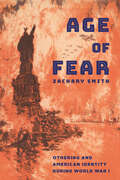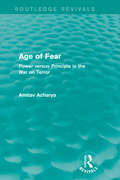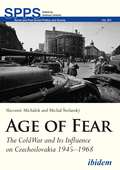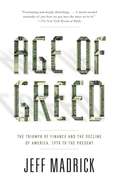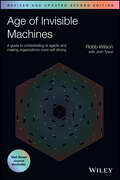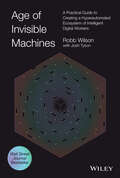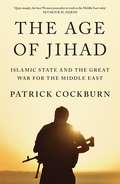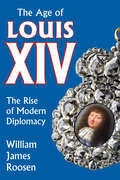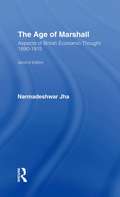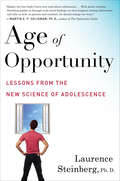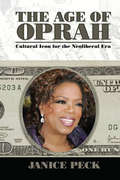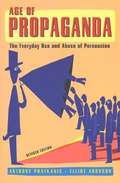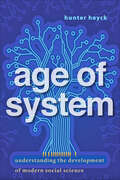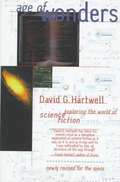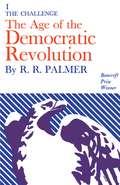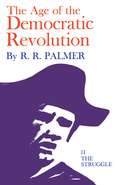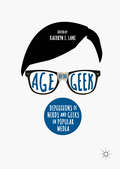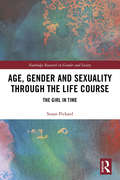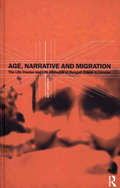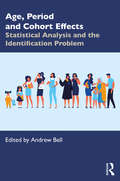- Table View
- List View
Age of Fear: Othering and American Identity during World War I
by Zachary SmithFear can be more dangerous than the threats we think loom over us—how Germans and German Americans were perceived as a dangerous enemy during World War I.Although Americans have long celebrated their nation's diversity, they also have consistently harbored suspicions of foreign peoples both at home and abroad. In Age of Fear, Zachary Smith argues that, as World War I grew more menacing and the presumed German threat loomed over the United States, many white "Anglo-Saxon" Americans grew increasingly concerned about the vulnerability of their race, culture, and authority. Consequently, they directed their long-held apprehensions over ethnic and racial pluralism onto their German neighbors and overseas enemies whom they had once greatly admired.Smith examines the often racially tinged, apocalyptic arguments made during the war by politicians, propaganda agencies, the press, novelists, and artists. He also assesses citizens' reactions to these messages and explains how the rise of nationalism in the United States and Europe acted as a catalyst to hierarchical racism. Germans in both the United States and Europe eventually took the form of the proverbial "Other," a dangerous, volatile, and uncivilized people who posed an existential threat to the nation and all that Anglo-Saxon Americans believed themselves to be. Exploring what the Great War meant to a large portion of the white American population while providing a historic precedent for modern-day conceptions of presumably dangerous foreign Others, Age of Fear is a compelling look at how the source of wartime paranoia can be found in deep-seated understandings of racial and millennial progress.
Age of Fear: Power Versus Principle in the War on Terror (Routledge Revivals)
by Amitav AcharyaFirst published in 2004 in the immediate wake of the September 11 terrorist attacks, this is an accessible commentary intended to provoke thought and debate on the topic of terrorism. In a collection of challenging essays, questions consider the causes of terrorism and why post-modern terrorism is different. The essays are divided into three key sections, first investigating the civilizational roots and dimensions of contemporary terrorism, next examining the Bush administration’s approach, and finally, considering the complex and changing relationship between fear and freedom. Written by a leading scholar in Middle East and Asian Studies, this comprehensive reissue will be of particular value to students of international relations and terrorism studies, as well as the more general reader with an interest in the global issues faced in the age of contemporary terrorism.
Age of Fear: The Cold War and Its Influence on Czechoslovakia, 1945–1968 (Soviet and Post-Soviet Politics and Society #201)
by Slavomír Michálek Michal ŠtefanskýCzechoslovakia played an important role within the Soviet bloc, yet its history remains underresearched. This monograph blends historical analysis of the superpowers’ foreign policies with an assessment of their impact on Czechoslovakia and its position within the Soviet bloc. The book thereby places Czechoslovakia on the map of Cold War history, i.e. the era of “mutually assured destruction” that lasted almost half a century. <P><P> It provides a lucid introduction to some milestones in international Cold War history in their relation to Czecho-Slovak history. The book’s novel contribution is to explain Czechoslovakia’s domestic situation during the Cold War from the “outside.” Drawing on extensive source materials of Slovak, Czech, American, and Russian provenance, it provides a more comprehensive understanding of postwar Czecho-Slovak history while also contributing to general knowledge about the nature and impact of the Cold War.
Age of Folly: America Abandons Its Democracy
by Lewis H. LaphamAmerica's leading essayist on the frantic retreat of democracy, in the fire and smoke of the war on terrorIn twenty-five years of imperial adventure, America has laid waste to its principles of democracy. The self-glorifying march of folly steps off at the end of the Cold War, in an era when delusions of omnipotence allowed the market to climb to virtual heights, while society was divided between the selfish and frightened rich and the increasingly debt-ridden and angry poor. The new millennium saw the democratic election of an American president nullified by the Supreme Court, and the pretender launching a wasteful, vainglorious and never-ending war on terror, doomed to end in defeat and the loss of America's prestige abroad.All this culminates in the sunset swamp of the 2016 election--a farce dominated by Donald Trump, a self-glorifying photo-op bursting star-spangled bombast in air. This spectacle would be familiar to Aristotle, whose portrayal of the "prosperous fool" describes a class of people who "consider themselves worthy to hold public office, for they already have the things that give them a claim to office."From the Hardcover edition.
Age of Greed: The Triumph of Finance and the Decline of America, 1970 to the Present
by Jeff MadrickA vividly told history of how greed bred America's economic ills over the last forty years, and of the men most responsible for them.As Jeff Madrick makes clear in a narrative at once sweeping, fast-paced, and incisive, the single-minded pursuit of huge personal wealth has been on the rise in the United States since the 1970s, led by a few individuals who have argued that self-interest guides society more effectively than community concerns. These stewards of American capitalism have insisted on the central and essential place of accumulated wealth through the booms, busts, and recessions of the last half century, giving rise to our current woes.In telling the stories of these politicians, economists, and financiers who declared a moral battle for freedom but instead gave rise to an age of greed, Madrick traces the lineage of some of our nation's most pressing economic problems. He begins with Walter Wriston, head of what would become Citicorp, who led the battle against government regulation. He examines the ideas of economist Milton Friedman, who created the plan for an anti-Rooseveltian America; the politically expedient decisions of Richard Nixon that fueled inflation; the philosophy of Alan Greenspan, on whose libertarian ideology a house of cards was built on Wall Street; and the actions of Sandy Weill, who constructed the largest financial institution in the world, which would have gone bankrupt in 2008 without a federal bailout of $45 billion. Significant figures including Ivan Boesky, Michael Milken, Jack Welch, and Ronald Reagan play key roles as well.Intense economic inequity and instability is the story of our age, and Jeff Madrick tells it with style, clarity, and an unerring command of his subject.From the Hardcover edition.
Age of Icons
by Martijn Konings Gavin FridellCelebrities are increasingly front and centre in public debates on everything from solving world poverty to halting genocide, confronting obesity, and finding spiritual contentment. Bono, Bill Gates, Al Gore, Bob Geldof, Oprah, Madonna, and Angelina Jolie are just some of the entertainers, politicians, pundits, elite business people, and policy-makers whose highly visible political activism has become an integral part of their public personas.These pop icons tend to be celebrated as "philanthrocapitalists" with a unique ability to remedy the world's problems. However, as Age of Icons demonstrates, the solutions these icons promote for addressing global injustice, when examined critically, can be seen to work through the very same institutions that create these problems in the first place.This volume assesses the growing role of popular icons in the construction of a culture that appears to incorporate a critical attitude towards the capitalist experience while, in fact, legitimizing the neoliberal character of the modern world. It will be an eye-opening read for anyone interested in the juncture between current events and celebrity culture.
Age of Invisible Machines: A Guide to Orchestrating AI Agents and Making Organizations More Self-Driving, Revised and Updated
by Robb Wilson Josh TysonCut through the noise and unlock the transformational power of conversational AI In the newly revised second edition of Age of Invisible Machines, renowned tech leader Robb Wilson delivers a startlingly insightful and eye-opening blueprint for using conversational AI to make your company self-driving—with a digital ecosystem of interconnected automations powering all aspects of your business. Conversational AI is transforming every job at every company (starting yesterday) and this book is perfect for anyone affected by these technologies. You'll learn how to develop a hyperautomation strategy by identifying outdated processes and systems holding your company back. This latest edition offers brand new chapters dedicated to fast-growing automation tools, including Large Language Models, generative AI, and much more. You'll discover ways to implement new technologies that are force-multipliers for rapid growth. A must-read for every business leader, Wilson's book debunks common myths about conversational AI while simplifying the inevitable complexity of restructuring your business to unlock the substantial opportunities this new era offers. You'll also find: Incisive discussions of the ethical dilemmas that lie before us as mass adoption of conversational AI takes effect Fascinating examinations of what a self-driving business looks like and how you can use conversational AI to generate an enduring competitive advantage Strategies for creating a hyperautomated ecosystem that any company can begin using immediately QR links to interactive and ongoing discussions of the subjects covered in each chapter A practical and essential exploration of the future of conversational AI and hyperautomation, Age of Invisible Machines belongs in the hands of entrepreneurs, founders, business leaders, tech enthusiasts, designers and anyone else with a stake in the future of business.
Age of Invisible Machines: A Practical Guide to Creating a Hyperautomated Ecosystem of Intelligent Digital Workers
by Robb WilsonCut through the hype and unlock the game-changing potential of conversational AI. In Age of Invisible Machines, celebrated tech leader Robb Wilson delivers an eye-opening and startlingly insightful blueprint for leveraging conversational AI in order to make your organization self-driving—with a growing ecosystem of interconnected automations accelerating all aspects of your business. Conversational AI is changing the nature of every job at every company (starting yesterday) and this book is relevant for anyone who will be affected by the acceleration of these technologies. You&’ll learn how to develop a strategy for hyperautomation by identifying the outdated processes and systems holding your organization back. You&’ll discover ways of internalizing and orchestrating new technologies that are force-multipliers for rapid growth. A must-read for every business leader, Wilson&’s book debunks common myths about conversational AI while laying bare the inevitable complexity of restructuring your business to unlock the massive opportunities this new era affords. You&’ll also find: Compelling discussions of the ethical dilemmas that lie in wait as mass adoption of conversational AI takes hold Fascinating explorations of what a self-driving organization looks like and how you can use conversational AI to create a durable competitive advantage Strategies behind creating an ecosystem for hyperautomation that any company can begin implementing immediately QR links to ongoing, interactive online discussions of the material covered in each chapter An essential and practical discussion of the future of conversational AI and hyperautomation, Age of Invisible Machines belongs in the hands of founders, entrepreneurs, business leaders, designers, tech enthusiasts, and anyone else with a stake in the future of business.
Age of Jihad: Islamic State and the Great War for the Middle East
by Patrick CockburnFrom the award-winning author of The Rise of Islamic State, the essential story of the Middle East's disintegrationThe Age of Jihad charts the turmoil of today's Middle East and the devastating role the West has played in the region from 2001 to the present. Beginning with the US-led invasion of Afghanistan, Cockburn explores the vast geopolitical struggle that is the Sunni-Shia conflict, a clash that shapes the war on terror, western military interventions, the evolution of the insurgency, the civil wars in Yemen, Libya and Syria, the Arab Spring, the fall of regional dictators, and the rise of Islamic State. As Cockburn shows in arresting detail, Islamic State did not explode into existence in Syria in the wake of the Arab Spring, as conventional wisdom would have it. The organization gestated over several years in occupied Iraq, before growing to the point where it can threaten the stability of the whole region. Cockburn was the first Western journalist to warn of the dangers posed by Islamic State. His originality and breadth of vision make The Age of Jihad the most in-depth analysis of the regional crisis in the Middle East to date.From the Hardcover edition.
Age of Louis XIV: The Rise of Modern Diplomacy
by William James RoosenWilliam James Roosen has written the first general study of European diplomacy in the age of Louis XIV which is based on the actual practices and institutions of that era, rather than on the writing of early theoreticians.Though the seventeenth century may not have been a period of great innovations in international diplomacy, it provides us with an important illustration of the "workings of a system which was well suited to the gradually changing needs of its time" and which has been called "the best form of diplomacy ever developed."Dr. Roosen demonstrates both the obvious differences and the many similarities between diplomatic procedures and practices of the seventeenth century and the twentieth. Any student of diplomacy and international relations will gain valuable insight and understanding from this study of the early modern diplomatic personalities, institutions, and practices.One of Dr. Roosen's goals in writing this book has been to discover the relationships between the ideological and socioeconomic structures and the diplomatic personalities who have influenced modern diplomacy. Further, he supplies the only available study of the realities of diplomatic practices in seventeenth century Europe, and provides an excellent basis for comparison with twentieth century international relations, in the hope that "studying early modern diplomatic personalities, institutions and practices should increase our understanding of international relations today."There are chapters on "The States of Europe," "Kings and Ministers," "Ambassadors," "Second Class Diplomats," "A Typical Early Modern Embassy," "Information: Important Objective of Diplomatic Activity," and "The Variety of Diplomatic Duties.
Age of Marshall: Aspects of British Economic Thought
by Narmedeshwar JhaFirst published in 1973. This is the second edition and nine years after when The Age of Marshall was first published. The period 1890-1915 in the history of British Economic Thought may aptly be described as the Age of Marshall. His influence as teacher, and his ideas as presented in the Principles of Economics (1890) and other writings, stimulated and often dominated the ideas and writings of most of the younger economists of the period. His ideas also provided a theoretical basis for increasing state intervention in economic life of the community in Britain and thus helped the Liberal Government of Great Britain lay the foundations of a Welfare State.
Age of Onset of Mental Disorders: Etiopathogenetic and Treatment Implications
by Norman Sartorius Giovanni De Girolamo Patrick D. McGorryThis book presents a thorough and critical review of current knowledge about the age of onset of mental disorders. The opening chapters offer information about the impact of the age of onset on the clinical picture, course, and outcome of physical illnesses, and about the neurobiological implications and correlates of different ages of onset. The impact and correlates of the ages of onset of all the most important mental disorders are then discussed in detail by internationally renowned scientists. The background to the book is the recognition that a better understanding of age of onset makes it possible to estimate the lifetime risk of disorders, helps to elucidate pathogenesis, and facilitates efficient, targeted clinical management. The book will be of value for clinicians, mental health professionals, mental health researchers, epidemiologists, and different stakeholders in the mental health field.
Age of Opportunity
by Laurence SteinbergA leading authority draws on new research to explain why the adolescent years are so developmentally crucial, and what we must do to raise happier, more successful kids.Adolescence now lasts longer than ever before. And as world-renowned expert on adolescent psychology Dr. Laurence Steinberg argues, this makes these years the key period in determining individuals' life outcomes, demanding that we change the way we parent, educate, and understand young people.In Age of Opportunity, Steinberg leads readers through a host of new findings -- including groundbreaking original research -- that reveal what the new timetable of adolescence means for parenting 13-year-olds (who may look more mature than they really are) versus 20-somethings (who may not be floundering even when it looks like they are). He also explains how the plasticity of the adolescent brain, rivaling that of years 0 through 3, suggests new strategies for instilling self-control during the teenage years. Packed with useful knowledge, Age of Opportunity is a sweeping book in the tradition of Reviving Ophelia, and an essential guide for parents and educators of teenagers.
Age of Oprah: Cultural Icon for the Neoliberal Era (Media and Power)
by Janice PeckOver the last two decades Oprah Winfrey's journey has taken her from talk show queen to-as Time Magazine has asserted-"one of the most important figures in popular culture." Through her talk show, magazine, website, seminars, charity work, and public appearances, her influence in the social, economic, and political arenas of American life is considerable and until now, largely unexamined. In The Age of Oprah, media scholar and journalist Janice Peck traces Winfrey's growing cultural impact and illustrates the fascinating parallels between her road to fame and fortune and the political-economic rise of neoliberalism in this country. While seeking to understand Oprah's ascent to the near- iconic status that she enjoys today, Peck's book provides a fascinating window into the intersection of American politics and culture over the past quarter century.
Age of Propaganda: The Everyday Use and Abuse of Persuasion
by Elliot Aronson Anthony H. PratkanisAmericans create 57% of the world's advertising while representing only 6% of its population; half of our waking hours are spent immersed in the mass media. Persuasion has always been integral to the democratic process, but increasingly, thoughtful discussion is being replaced with simplistic soundbites and manipulative messages. Drawing on the history of propaganda as well as on contemporary research in social psychology, Age of Propaganda shows how the tactics used by political campaigners, sales agents, advertisers, televangelists, demagogues, and others often take advantage of our emotions by appealing to our deepest fears and most irrational hopes, creating a distorted vision of the world we live in. This revised and updated edition includes coverage of the Clinton/Lewinsky scandal, recent election campaigns, talk radio, teen suicide, U. F. O. abductions, the Columbine shootings, and novel propaganda tactics based on hypocrisy and false allegations.
Age of Revolutions: Progress and Backlash from 1600 to the Present
by Fareed ZakariaThe CNN host and best-selling author explores the revolutions—past and present—that define the polarized and unstable age in which we live. <p><p> Populist rage, ideological fracture, economic and technological shocks, war, and an international system studded with catastrophic risk—the early decades of the twenty-first century may be the most revolutionary period in modern history. But it is not the first. Humans have lived, and thrived, through more than one great realignment. What are these revolutions, and how can they help us to understand our fraught world? <p><p> In this major work, Fareed Zakaria masterfully investigates the eras and movements that have shaken norms while shaping the modern world. Three such periods hold profound lessons for today. First, in the seventeenth-century Netherlands, a fascinating series of transformations made that tiny land the richest in the world—and created politics as we know it today. Next, the French Revolution, an explosive era that devoured its ideological children and left a bloody legacy that haunts us today. Finally, the mother of all revolutions, the Industrial Revolution, which catapulted Great Britain and the US to global dominance and created the modern world. <p><p> Alongside these paradigm-shifting historical events, Zakaria probes four present-day revolutions: globalization, technology, identity, and geopolitics. For all their benefits, the globalization and technology revolutions have produced profound disruptions and pervasive anxiety and our identity. And increasingly, identity is the battlefield on which the twenty-first century’s polarized politics are fought. All this is set against a geopolitical revolution as great as the one that catapulted the United States to world power in the late nineteenth century. Now we are entering a world in which the US is no longer the dominant power. As we find ourselves at the nexus of four seismic revolutions, we can easily imagine a dark future. But Zakaria proves that pessimism is premature. If we act wisely, the liberal international order can be revived and populism relegated to the ash heap of history. <p><p> As few public intellectuals can, Zakaria combines intellectual range, deep historical insight, and uncanny prescience to once again reframe and illuminate our turbulent present. His bold, compelling arguments make this book essential reading in our age of revolutions. <p> <b>New York Times Bestseller</b>
Age of Secession
by Griffiths Ryan D.What are the factors that determine how central governments respond to demands for independence? Secessionist movements are numerous and quite varied in form, but the chief obstacle to their ambitions is the state itself, which can deny independence demands, deploy force if need be, and request that the international community respect its territorial integrity by not recognizing the breakaway region. Age of Secession focuses on this crucial but neglected moment in the life of a secessionist movement. Griffiths offers a novel theory using original data on secessionist movements between 1816 and 2011. He explains how state response is shaped by international and domestic factors, when conflict is likely, and why states have proliferated since 1945. He mixes quantitative methods with case studies of secessionist movements in the United Kingdom, Russia/Soviet Union, and India. This is an important book for anyone who wants to understand the phenomenon of secession.
Age of System: Understanding the Development of Modern Social Science
by Hunter HeyckIn the years after World War II, a new generation of scholars redefined the central concepts and practices of social science in America.Before the Second World War, social scientists struggled to define and defend their disciplines. After the war, "high modern" social scientists harnessed new resources in a quest to create a unified understanding of human behavior—and to remake the world in the image of their new model man.In Age of System, Hunter Heyck explains why social scientists—shaped by encounters with the ongoing "organizational revolution" and its revolutionary technologies of communication and control—embraced a new and extremely influential perspective on science and nature, one that conceived of all things in terms of system, structure, function, organization, and process. He also explores how this emerging unified theory of human behavior implied a troubling similarity between humans and machines, with freighted implications for individual liberty and self-direction. These social scientists trained a generation of decision-makers in schools of business and public administration, wrote the basic textbooks from which millions learned how the economy, society, polity, culture, and even the mind worked, and drafted the position papers, books, and articles that helped set the terms of public discourse in a new era of mass media, think tanks, and issue networks. Drawing on close readings of key texts and a broad survey of more than 1,800 journal articles, Heyck follows the dollars—and the dreams—of a generation of scholars that believed in "the system." He maps the broad landscape of changes in the social sciences, focusing especially intently on the ideas and practices associated with modernization theory, rational choice theory, and modeling. A highly accomplished historian, Heyck relays this complicated story with unusual clarity.
Age of Wonders: Exploring the World of Science Fiction
by David G. Hartwell"A landmark work. Daring, imaginative, witty-- it is the best commentary on the field yet written." --Roger Zelazny creator of the Amber series An insider's view of the strange and wonderful world of science fiction, by one of the most respected editors in the field Like those other American-art forms, jazz, comics, and rock 'n' roll, science fiction is the product of a rich and fascinating subculture. Age of Wonders is a fascinating tour of the origins, history, and culture of the science fiction world, written with insight and genuine affection for this wonder-filled literature, and addressed to newcomers and long time SF readers alike. "Should appeal to both longtime readers and people who have never understood science fiction's appeal .... Anyone who wants to know what SF is about must read this book."
Age of the Democratic Revolution: The Challenge (Princeton Classics Ser. #90)
by R. R. PalmerFor the Western world as a whole, the period from about 1760 to 1800 was the great revolutionary era in which the outlines of the modern democratic state came into being. It is the thesis of this major work that the American, French, and Polish revolutions, and the movements for political change in Britain, Ireland, Holland, Belgium, Switzerland, Sweden, and other countries, though each distinctive in its own way, were all manifestations of recognizably similar political ideas, needs, and conflicts.
Age of the Democratic Revolution: The Struggle (Princeton Classics Ser. #90)
by R. R. PalmerFor the Western world as a whole, the period from about 1760 to 1800 was the great revolutionary era in which the outlines of the modern democratic state came into being. It is the thesis of this major work that the American, French, and Polish revolutions, and the movements for political change in Britain, Ireland, Holland, Belgium, Switzerland, Sweden, and other countries, although each distinctive in its way, were all manifestations of recognizably similar political ideas, needs, and conflicts.Volume 1 of this distinguished two-volume work, "The Challenge," received critical accolades throughout the world. It was the winner of the Bancroft Prize in 1960 and was called "one of the classic works of American historical scholarship" (Key Reporter) and a book which "will enlarge and clarify our understanding of modern Western history. It will re-emphasize the strength and vitality of the roots that supported the growth of democracy in the Old and New Worlds" (New York Times). "Occasionally a historical work appears which, by synthesis of much previous specialized work and by intelligent reflection upon the whole, makes events of the past click into a new pattern and assume fresh meaning. Professor Palmer's book is such a work" (American Historical Review)."The Challenge" took the story to the eve of the French Revolutionary wars; Volume 2, "The Struggle" continues the account to 1800.
Age of the Geek: Depictions of Nerds and Geeks in Popular Media
by Kathryn E. LaneThis collection examines the nerd and/or geek stereotype in popular culture today. Utilizing the media--film, TV, YouTube, Twitter, fiction--that often defines daily lives, the contributors interrogate what it means to be labeled a "nerd" or "geek. " While the nerd/geek that is so easily recognized now is assuredly a twenty-first century construct, an examination of the terms' history brings a greater understanding of their evolution. From sports to slasher films, Age of the Geek establishes a dialogue with texts as varied as the depictions of "nerd" or "geek" stereotypes.
Age, Gender and Sexuality through the Life Course: The Girl in Time (Routledge Research in Gender and Society)
by Susan PickardAge, Gender and Sexuality through the Life Course argues that the gendered structure of temporality (defined in the dual sense of everyday time as well as age and stage of life) is a key factor underpinning the stalling of the gender revolution. Taking as its central focus the idealised young woman who serves as the mascot of contemporary success, this book demonstrates how the celebration of the Girl is (i) representative of social mobility, educational and professional achievement; (ii) possesses diligence, docility and emotional intelligence, and (iii) displays a reassuring sexuality and youthfulness – but is constructed from the outset to have a fleetingly short life span. Pickard undertakes a theoretical and empirical exploration of the contemporary female experience of education, work, motherhood, sexuality, the challenge of having-it-all. Furthermore, through additional analysis of the transitional ‘reproductive regime’ from youth into mid-life and beyond, this insightful monograph aims to demonstrate how age and time set very clear limits to what is possible and desirable for the female self; yet how the latter factors also, if used reflexively, can provide the key means of resisting and challenging patriarchy. This book is aimed at a broad interdisciplinary audience located in gender studies, age studies, culture studies, sociology and psychology; accessible for advanced undergraduates and beyond.
Age, Narrative and Migration: The Life Course and Life Histories of Bengali Elders in London
by Katy GardnerWhilst the vast majority of recent research on identity and ethnicity amongst South Asians in Britain has focused upon younger people, this book deals with Bengali elders, the first generation of migrants from Sylhet, in Bangladesh. The book describes how many of these elders face the processes of ageing, sickness and finally death, in a country where they did not expect to stay and where they do not necessarily feel they belong. The ways in which they talk about and deal with this, and in particular, their ambivalence towards Britain and Bangladesh lies at the heart of the book. Centrally, the book is based around the men and womens life stories. In her analysis of these, Gardner shows how narratives play an important role in the formation of both collective and individual identity and are key domains for the articulation of gender and age. Underlying the stories that people tell, and sometimes hidden within their gaps and silences, are often other issues and concerns. Using particular idioms and narrative devices, the elders talk about the contradictions and disjunctions of transmigration, their relationship with and sometimes resistance to, the British State, and what they often present as the breakdown of traditional ways. In addition to this, the book shows that histories, stories and identity are not just narrated through words, but also through the body - an area rarely theorized in studies of migration.
Age, Period and Cohort Effects: Statistical Analysis and the Identification Problem
by Andrew BellAge, Period and Cohort Effects: Statistical Analysis and the Identification Problem gives a number of perspectives from top methodologists and applied researchers on the best ways to attempt to answer Age–Period–Cohort related questions about society. Age–Period–Cohort (APC) analysis is a fundamental topic for any quantitative social scientist studying individuals over time. At the same time, it is also one of the most misunderstood and underestimated topics in quantitative methods. As such, this book is key reference material for researchers wanting to know how to deal with APC issues appropriately in their statistical modelling. It deals with the identification problem caused by the co-linearity of the three variables, considers why some currently used methods are problematic and suggests ideas for what applied researchers interested in APC analysis should do. Whilst the perspectives are varied, the book provides a unified view of the subject in a reader-friendly way that will be accessible to social scientists with a moderate level of quantitative understanding, across the social and health sciences.
